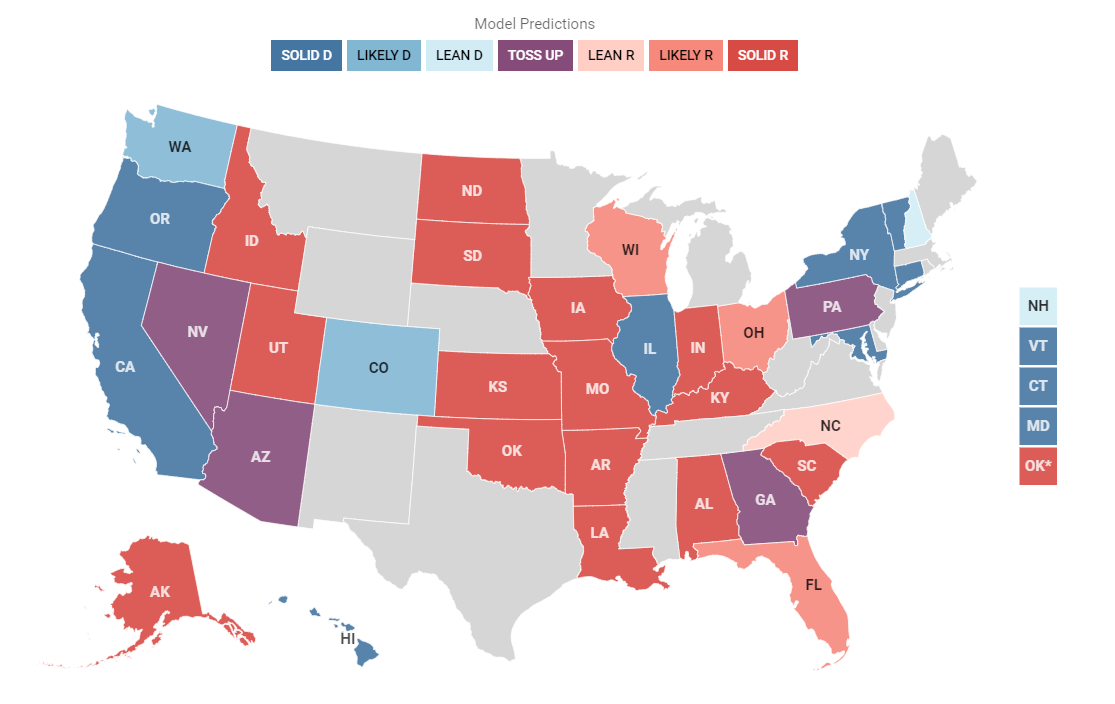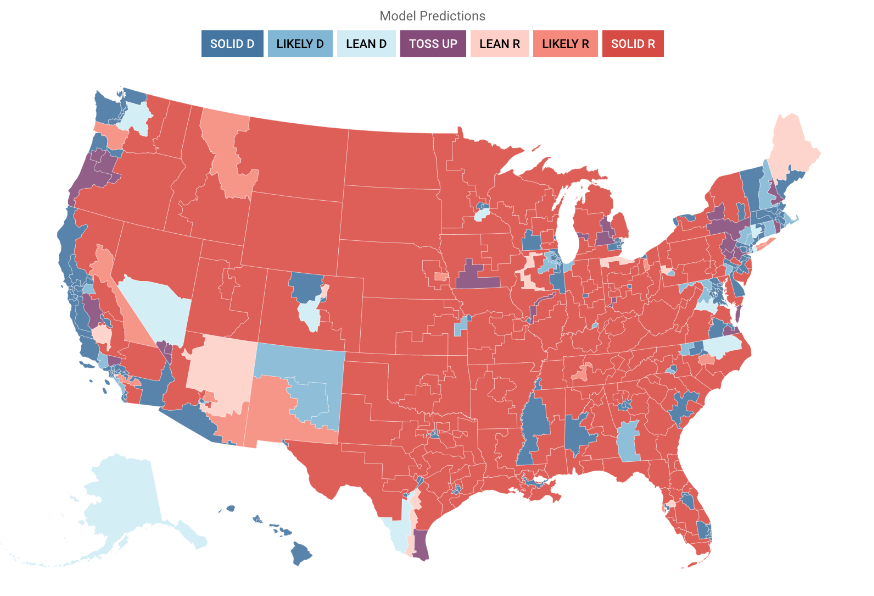Election day has arrived, and our final forecast for the 2022 midterms is here with the latest (and last) predictions for key congressional races and for House and Senate control. The 2022 cycle has been full of surprises, and here’s the state of the election according to DDHQ as voting concludes in every state.
Final Senate Forecast
Bottom-line: The Dem Senate majority is on treacherous footing as GOP candidates have picked up momentum in the weeks and days leading up to election day, and a number of races are competitive that were once comfortable for Democrats only a short time ago.
Over much of the cycle, our model has anticipated Dems holding onto their de-facto 50 Senate-seat majority, and running competitive races in GOP-held open seats in North Carolina and Pennsylvania. Today, the model shows Republicans with their largest-ever advantage in the Senate, with a 59% chance of controlling the chamber once all of the votes are counted. We project the GOP will pick up one additional seat in the Senate, with a delegation of 51 R and 49 D (and consequently end the Dem’s split-majority advantage with Democratic VP Kamala Harris’ tie breaking vote). We rate four Senate races in the “Toss Up” category (neither party has a >65% chance of winning the election): Pennsylvania, Georgia, Nevada, and Arizona. Wisconsin, Ohio, Florida, and North Carolina are rated either as “Lean R” (65-80% chance), or “Likely R” (80-95% chance).
The GOP gained momentum in a number of Senate races over the last month, despite the fact that Democrats held an advantage in our Senate forecast from late July to late October. As such, we enter Election Day 2022 in a much different electoral landscape than we had expected throughout the Summer. GOP candidates, although struggling at times in the polls against well-funded Dems, have had a near-universal resurgence in our polling averages in recent weeks.
In “Toss Up” races, our model shows increasingly bullish potential for GOP candidates before polls close on election night. Polling averages in these races stand at Pennsylvania Senate: Oz+0.7, Georgia Senate: Walker+1.1, NV Senate: Laxalt+2.6, and Kelly+0.8. In short, Republican candidates are favored in our polling average for each “Toss Up”, except for AZ Senate.
Just in time for election day, the Senate race in Arizona’s shift from “Lean D” to “Toss Up” completes a descent for Kelly’s chances that began several weeks ago. Kelly’s fall can largely be attributed to the race’s polling average. In mid-October our model rated the contest as “Likely D”, and Kelly had built a 6.7 point advantage in our average. Since then, Kelly’s probability of victory has fallen by 20 points as new polling has shown a significantly closer race.
Senate contests in Nevada, New Hampshire, and Ohio also head into election day as close races between widely-respected Dem candidates against Trump-endorsed GOP competitors. In New Hampshire, our model shows a (perhaps surprisingly) close race between Dem incumbent Sen. Maggie Hassan and GOP challenger Don Bolduc. Our model favors Hassan 2-1 over Bolduc, but the model has the race within just a few points of dropping into the “ Toss Up” column. NH Senate goes into election day as “Lean D”, with a poll average of D+0.8 and a 67% chance of winning for Hassan.
In Ohio, a strong GOP lean in the state’s fundamentals, as well as the overall favorable polling (especially from October onwards) for Republican J.D. Vance has the race now rated “Likely R”, with an 86% probability of victory for Vance over Ryan. Polling, and by association our model, for the Ohio Senate race has been among the most elastic this cycle: since the beginning of August, the race’s polling average has swung 11 points in favor of Vance, starting at Ryan+4 and ending at Vance+6.9.
In one of the quieter contested races this cycle (re: receiving less voter interest), Nevada has remained a “Toss Up” since mid-August. Our forecast shows GOP challenger Adam Laxalt with a 55% chance of unseating Dem incumbent Sen. Catherine Cortez Masto. Laxalt has led polling in the race since mid-August, and goes into today with the race polling at an average of Laxalt+2.3. As things stand, our model shows Nevada is of the GOP’s best chances to flip a seat from a Dem incumbent in the Senate.
Final House Forecast
Bottom-line: Longtime favorites for House control, our model has the GOP going into election day poised to win back the chamber. Republican candidates are in a favorable position to flip enough seats from both Dem-held open seats and Dem incumbents to win a majority (at least 218 seats) in the House.
Our model has twenty two “Toss Up” races in the House, with over 40 races rated as “Lean” or “Likely” D/R. The GOP has a significant (80%) chance of securing control of the House, and our model has a mean seat projection of 231 Republican seats to 204 Democratic (+20 for the GOP).
Our House model is strongly tied to our generic ballot polling average, and many candidates’ performance in the model can often be traced back to how voters feel about which party they prefer in Congress overall, as well as additional factors such as fundamentals, race polling, and fundraising. As the generic average has shifted between more or less favorable for Dems, a number of races have shown elastic favorability for GOP candidates. Coming into Election Day, the GOP leads our generic ballot average, R+2.09.
DDHQ has identified a few races that we believe could prove to be barometers for party control on election night. Our model shows strong Republican chances in VA-02, NH-01, MI-07, and MI-08 against Dem incumbents, which the GOP hopes to flip. Democratic candidates in NY-22 and AK At-Large are also battling it out in previously held GOP seats, with slight leads against their opponents in our final forecast.
—
With a number of Toss Ups in the Senate and a handful of competitive races in the House, our model forecasts control of both chambers flipping Republican, given the most recent data available. Several races for the Senate will likely prove to be very close, and could take days to call after election day. We’ll be watching closely as voters head to the polls and the 2022 midterms come to an end.

